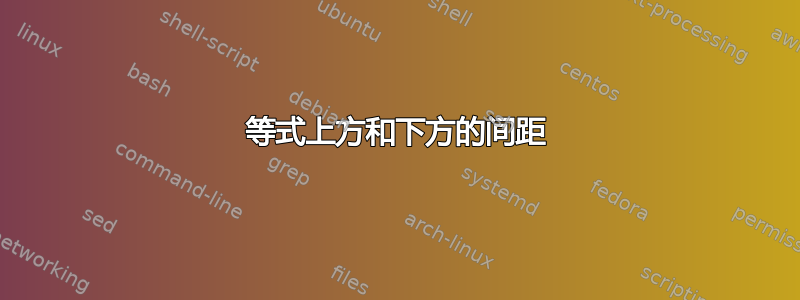
在我的论文中,我使用了很多方程式环境,但不仅仅是用于方程式本身。我用它来强调文本中的内容。但我感觉上面和下面的空间太多了。我没有为此更改任何选项,但像下面的代码中那样有这么多空间是正常的吗?
\documentclass[ngerman, fontsize=11pt, DIV=12 ,BCOR = 10mm, parskip=half-, twoside]{scrbook}
\usepackage{amsmath}
\usepackage{amssymb}
\counterwithout{equation}{chapter}
\begin{document}
We will use the following very often.
As the set of naturals numbers we have
\begin{equation*}
\mathbb N
=
\left\{
1,2,\dots
\right\}.
\end{equation*}
To note that two elements $a$ and $b$ are equivalent modulo an integer $n$ we will write
\begin{equation*}
a \equiv b \pmod n.
\end{equation*}
If we want to note the remainder of $a$ divided by $n$ we will write
\begin{equation*}
\left({a\bmod n}\right).
\end{equation*}
\end{document}
答案1
如上所述,调整垂直空间可能不是一个好主意,但如果必须的话,你可以使用负片空间值,例如下面的内容。
\documentclass[ngerman, fontsize=11pt, DIV=12 ,BCOR = 10mm, parskip=half-, twoside]{scrbook}
\usepackage{amsmath}
\usepackage{amssymb}
\counterwithout{equation}{chapter}
\begin{document}
We will use the following very often.
As the set of naturals numbers we have
\vspace{-5ex}
\begin{equation*}
\mathbb N
=
\left\{
1,2,\dots
\right\}.
\end{equation*}
To note that two elements $a$ and $b$ are equivalent modulo an integer $n$ we will write
\vspace{-5ex}
\begin{equation*}
a \equiv b \pmod n.
\end{equation*}
If we want to note the remainder of $a$ divided by $n$ we will write
\vspace{-5ex}
\begin{equation*}
\left({a\bmod n}\right).
\end{equation*}
\end{document}
希望有所帮助。
答案2
这是一个品味和习俗的问题。
如果愿意,您可以设置不同的间距(这里是标准的一半):
\documentclass[
% ngerman,
fontsize=11pt,
DIV=12,
BCOR = 10mm,
parskip=half-,
twoside,
]{scrbook}
\usepackage{amsmath}
\usepackage{amssymb}
\usepackage{lipsum}% for mock text
\counterwithout{equation}{chapter}
\AtBeginDocument{%
\setlength{\abovedisplayskip}{\skipeval{\abovedisplayskip/2}}%
\setlength{\belowdisplayskip}{\skipeval{\belowdisplayskip/2}}%
}
\begin{document}
\lipsum[1][1-4]
We will use the following very often.
As the set of naturals numbers we have
\begin{equation*}
\mathbb{N} = \{1,2,\dotsc\}.
\end{equation*}
To note that two elements $a$ and $b$ are equivalent modulo an integer $n$ we will write
\begin{equation*}
a \equiv b \pmod{n}.
\end{equation*}
If we want to note the remainder of $a$ divided by $n$ we will write
\begin{equation*}
({a\bmod n}).
\end{equation*}
\end{document}
与结果比较没有 parskip以及调整:
也许你会认为篇幅过大。但我想指出的是,parskip你的读者会不是能够区分新段落是否在第一个或第二个显示之后开始。
如果您有一个以您的设置开头的段落(以及减少的垂直间距),会发生什么情况?情况如下:
如果没有parskip,您将获得与第二张图片相同的垂直间距和段落缩进。
注意事项:\mathbb N是错误的,应该是\mathbb{N};\left并且\right在使用它们的地方只需添加不需要的水平空格;\dotsc是在逗号后省略号的正确命令,后面不需要另一个逗号。






